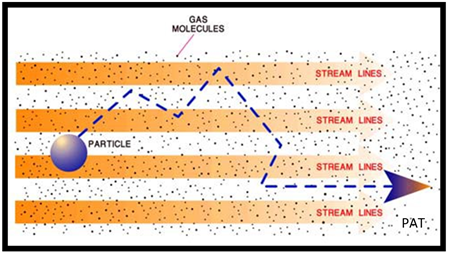The following describes particle behavior mechanisms and will assist in the understanding of particle counter tubing sampling difficulties and how to improve the efficiency of sampling.
- The Stokes number is the ratio of a particle’s radius to the dimension of an obstacle in fluid flow. This is an important factor in determining when a particle in motion will be collected by an obstacle or will pass around it. An obstacle could be a filter fiber or the sample inlet.
- The drag coefficient is the ratio of the force of gravity to the inertial force on a particle in fluid. It indicates how a particle will resist any force that could cause a change in the particle velocity. Smaller particles have smaller drag coefficients due to their lesser masses.
- The relaxation time is the time for a particle initially in equilibrium with a moving fluid to match a change in fluid velocity. Large particles have a long relaxation time. Therefore, when an air stream moves through tubing that contains small-radius bends or elbows, the large particles will deposit on a tube wall because they cannot adapt easily to sudden velocity changes because of tube curvature, and thus the particles will continue in their original direction until they impact on the tube wall. A related term to relaxation time is stopping distance, which is defined as the distance for a particle initially moving within a gas stream to come to a stop when the gas flow is halted, as by an obstacle.

- The deposition velocity or settling velocity is the ratio of particle flux (distance per unit time for sedimentation to occur) relative to the ambient particle concentration.
There are also additional forces in effect on particles that affect particle counter tubing and transportation. These additional forces on the particles and the particles’ subsequent response to such forces control the particles’ migration through the air:
- Viscous forces: The fluid dynamic force from a moving fluid stream or the viscous nature of an air stream will ‘pull’ particles along that flow path. If this flow is laminar, then other forces act upon the larger particles encouraging settling and deposition, while smaller particles remain buoyant on a laminar flow. In turbulent flow streams the larger particles are re- entrained back into the airflow and smaller particles are more prone to additional forces acting upon them.
- Brownian motion: As the particles migrate through a body of air, random impacts from individual molecules will cause them to veer from course.

- Gravitational force: The gravitational force on a particle varies with particle mass and the difference between particle and air density; the larger the particle the greater the interaction.
- Electrostatic forces: The electrostatic force on a particle varies with the particle’s electrical charge (surface area controlled) and the strength of the electrical field in which the particle is located. Electrostatic charge can develop as a particle slips through the air stream. It is important therefore to minimize these interactions in order to ensure all particles reach the final destination.
- Diffusion forces: This force on a particle varies inversely with the particle’s radius. Therefore smaller particles are more prone to interactions due to diffusion.
- Thermophoretic forces: These forces (effective mainly for small particles) vary with the particle’s surface area and temperature gradient.
A particle’s response to these forces is controlled by the particle’s size, mass, shape, and electrical charge. For essentially all of these forces the major parameter is particle size, because the magnitude of the several forces varies with particle size squared or cubed.
Get the full paper to learn more about particle counter tubing and:
- Isokinetic Sampling
- Particle Loss in Transport Tubing
- Particle Considerations and Guidance
Learn more… Get the full paper.

